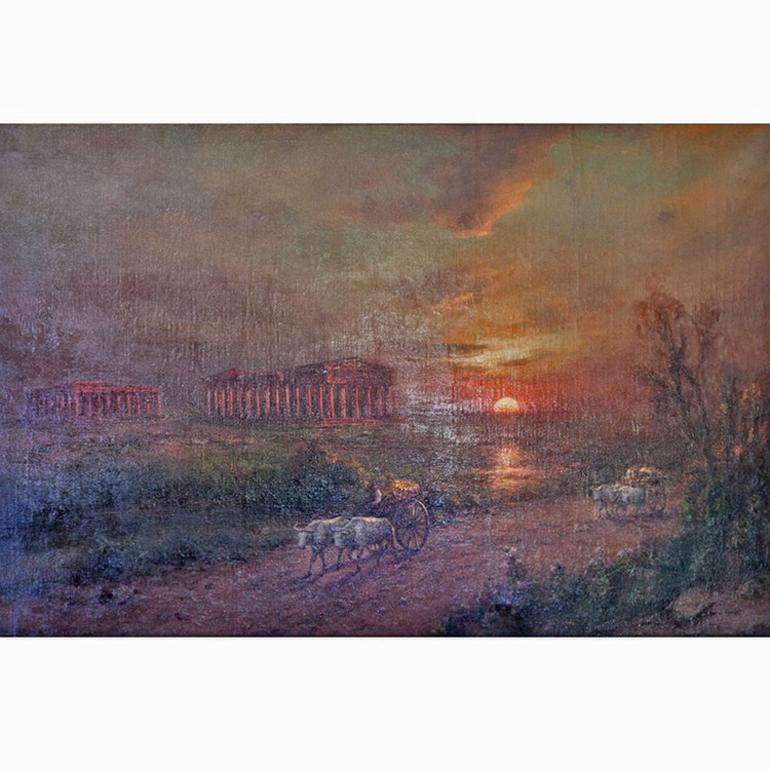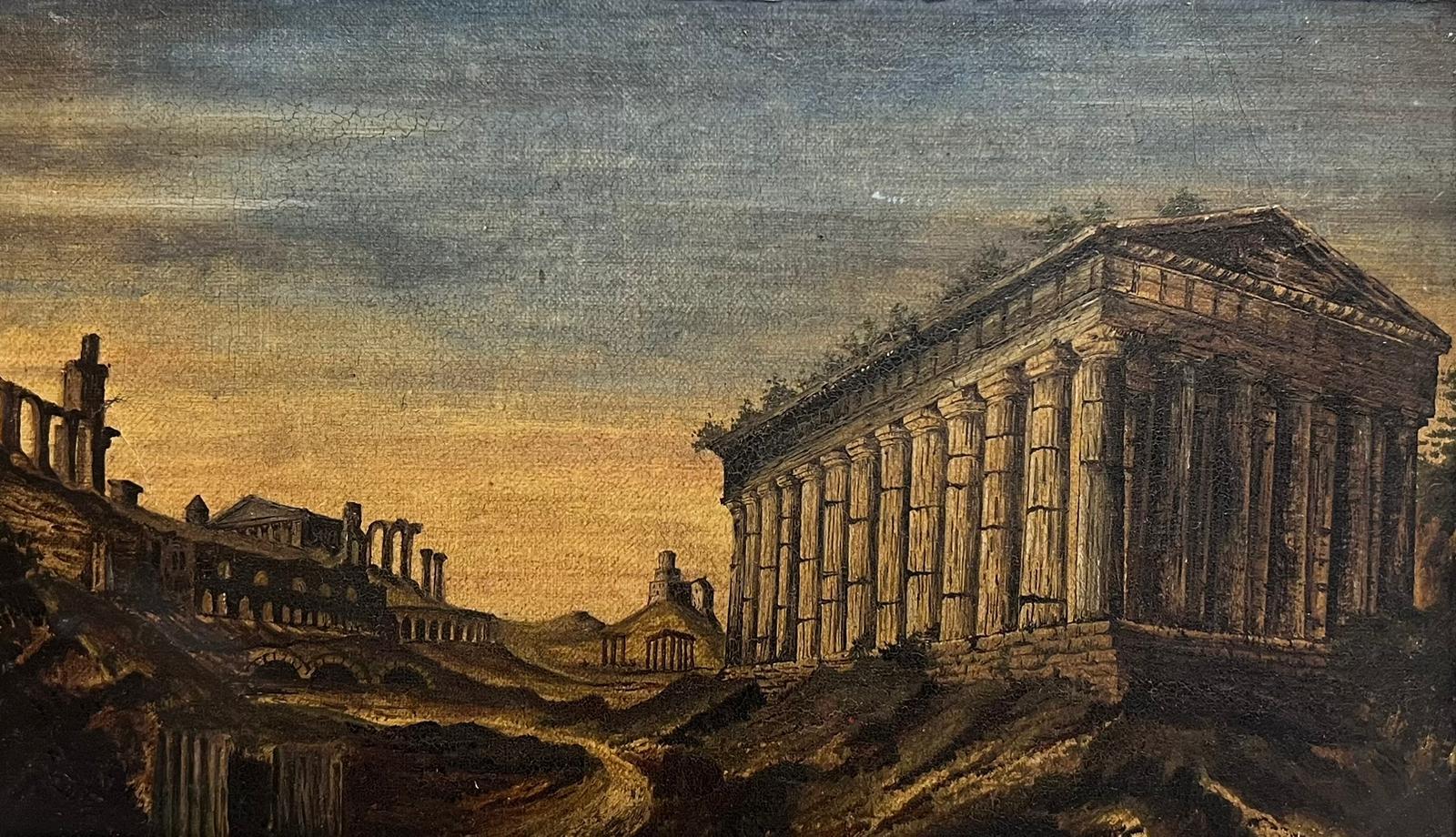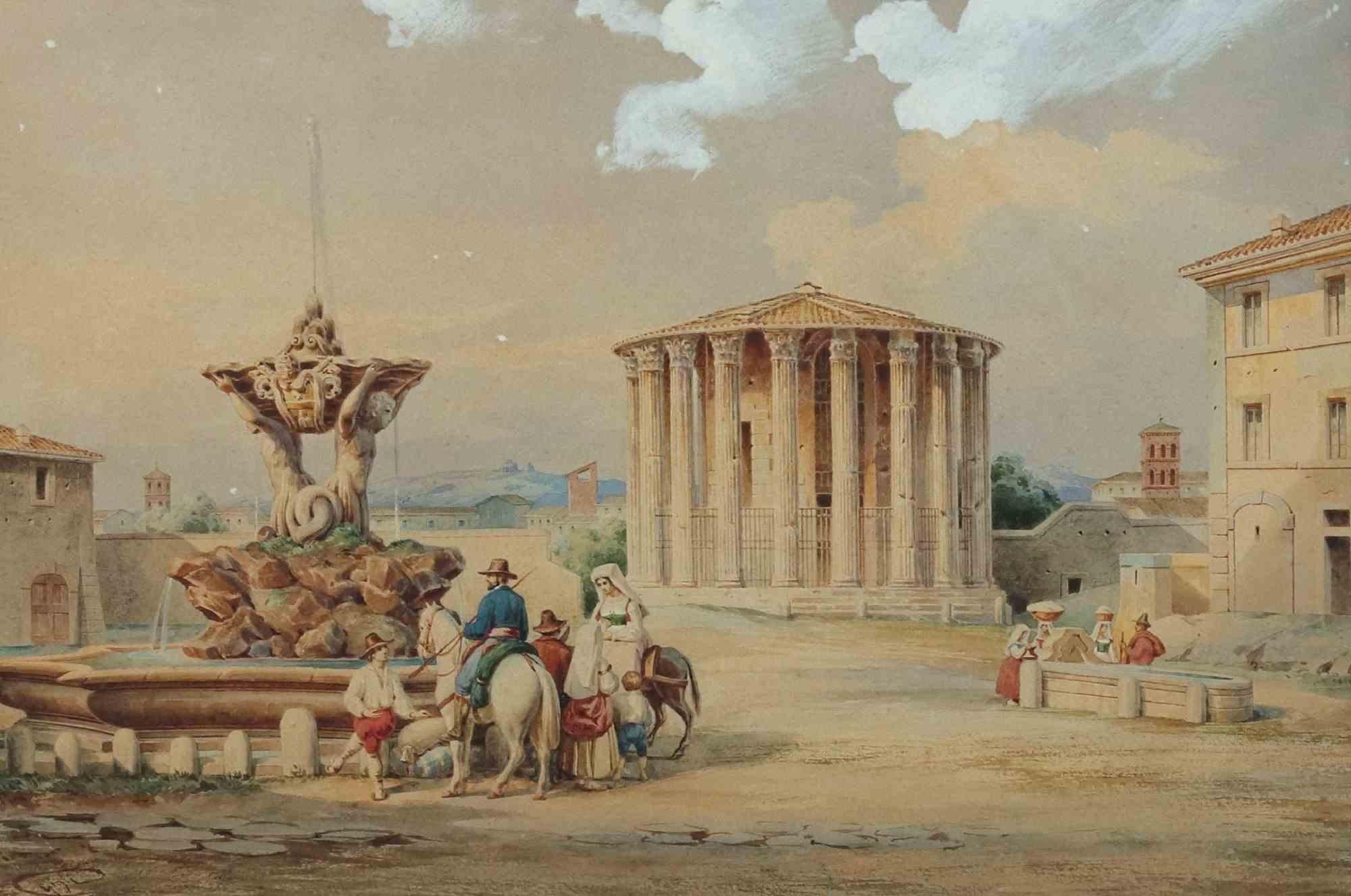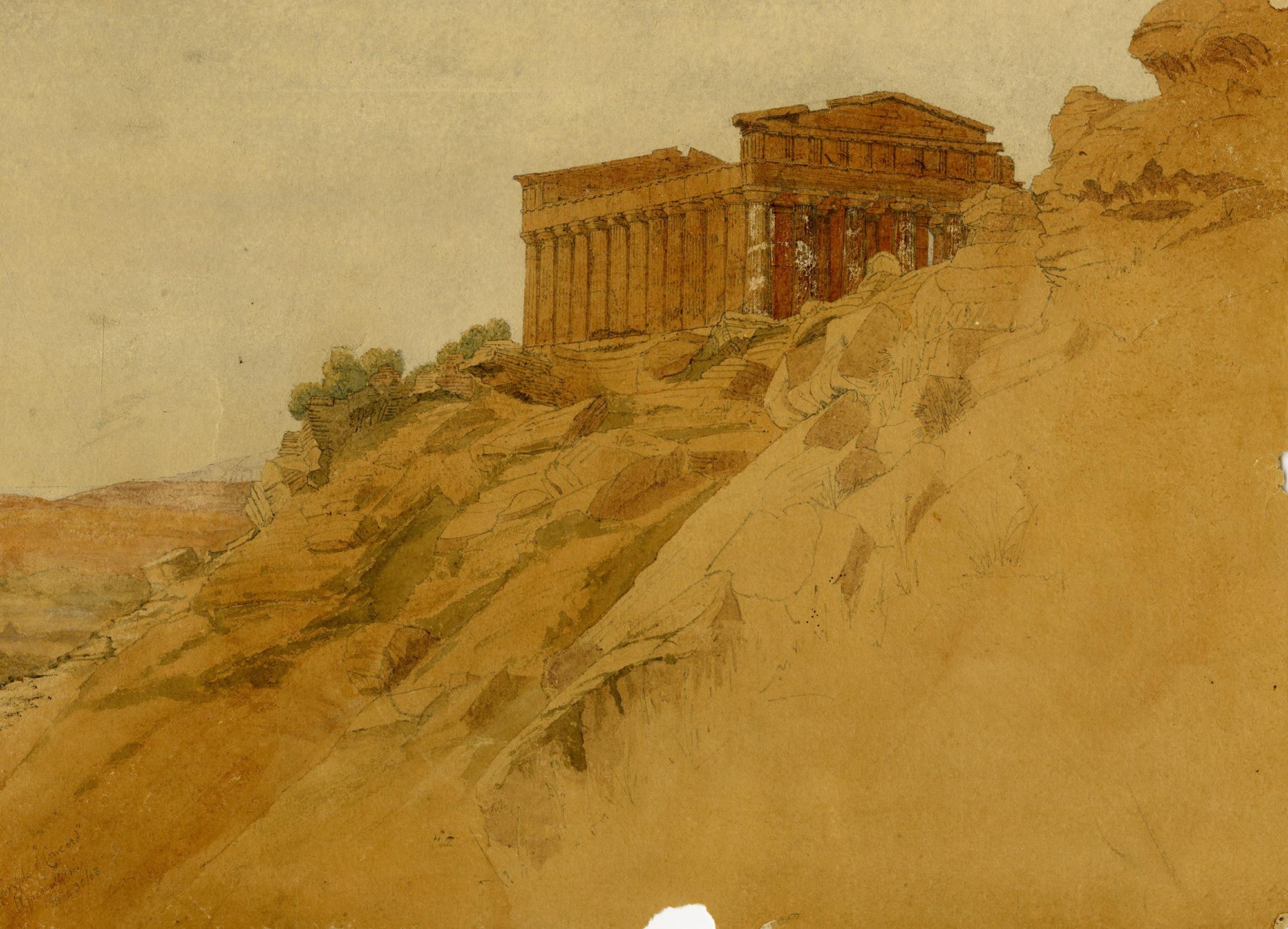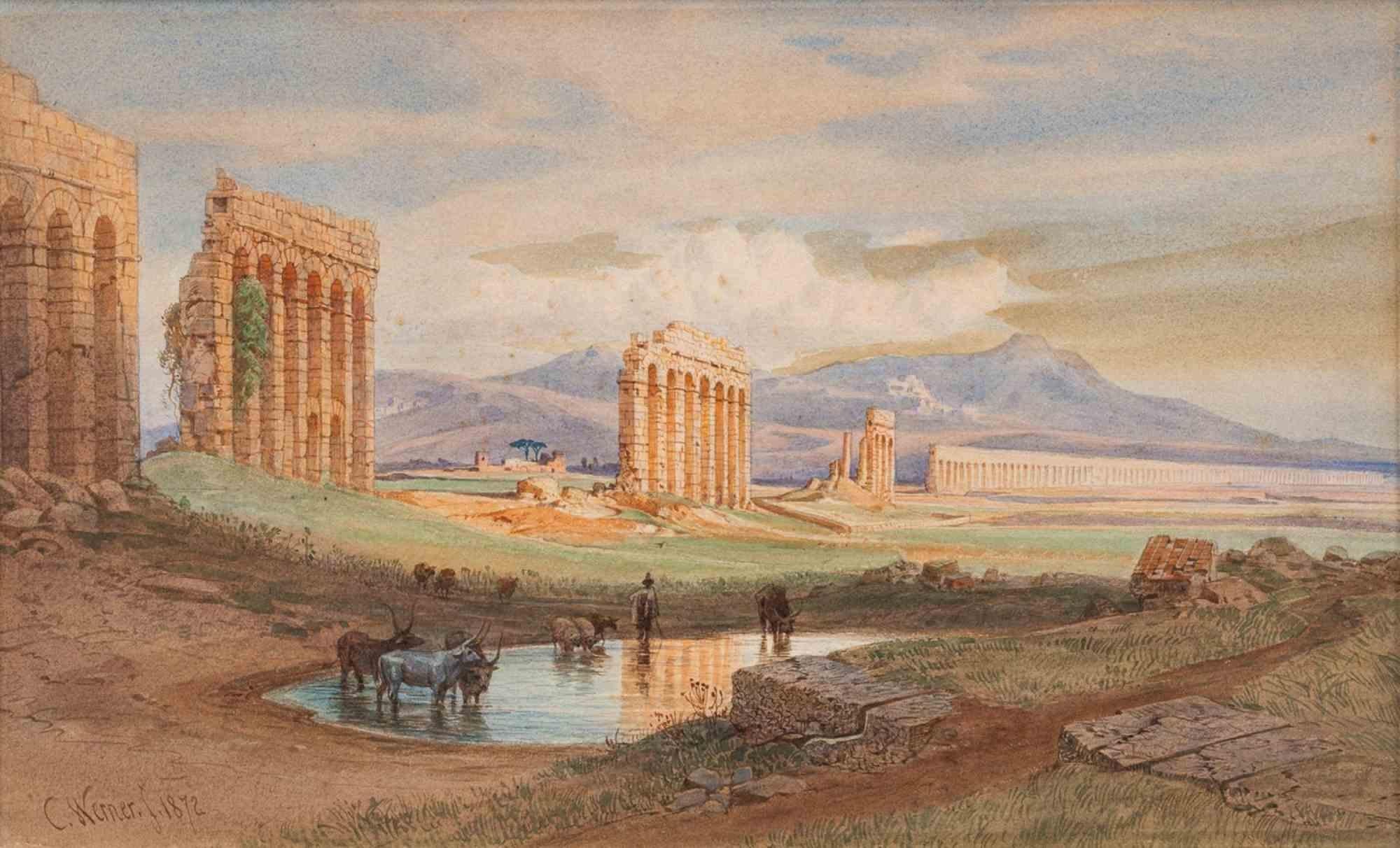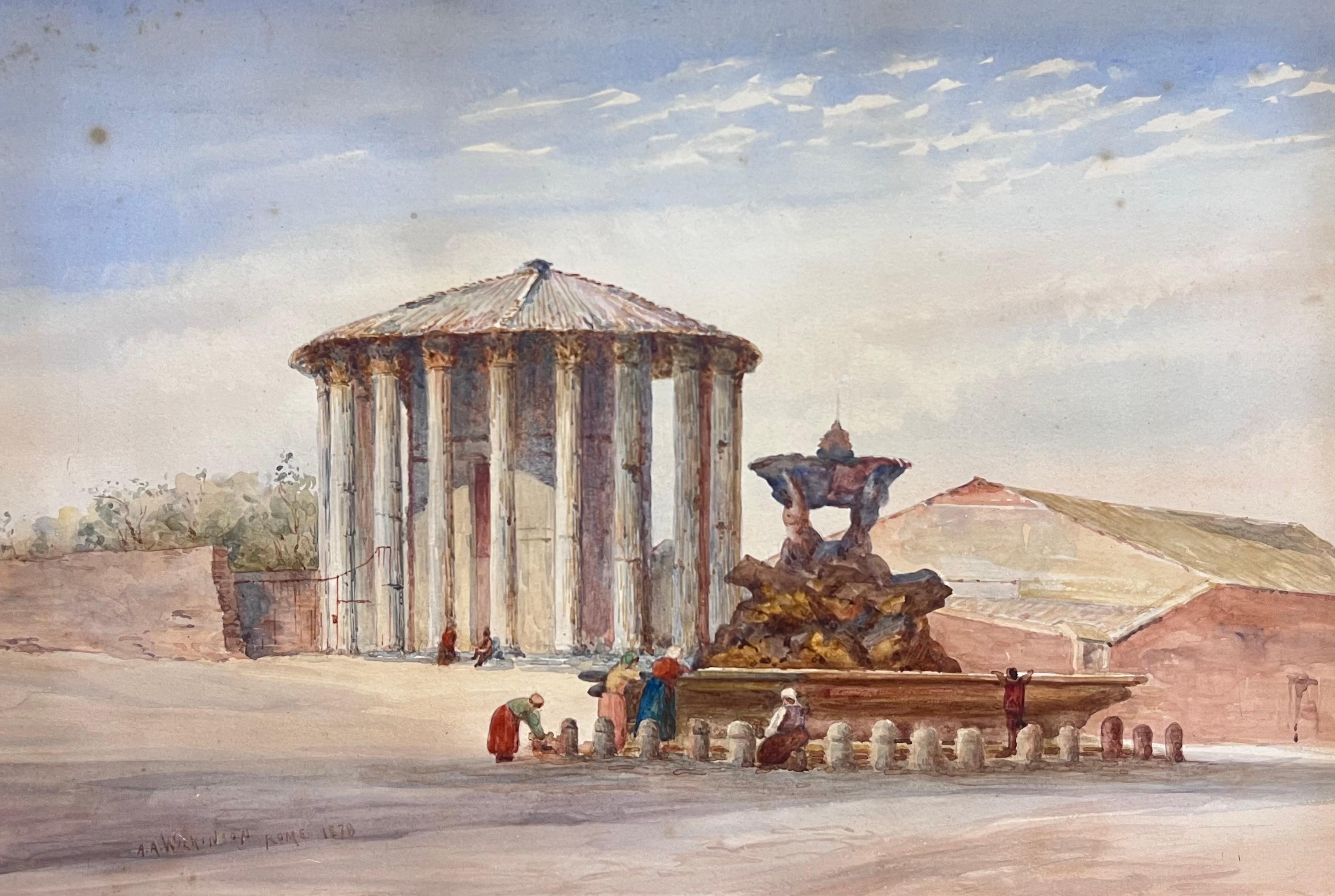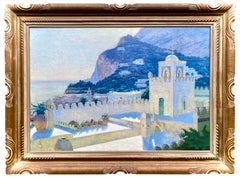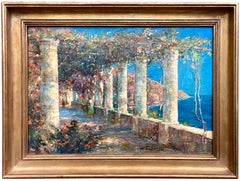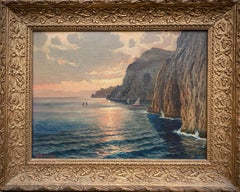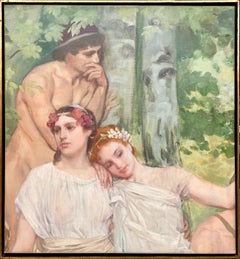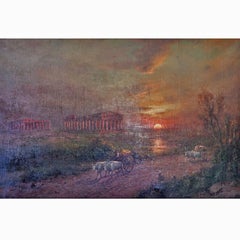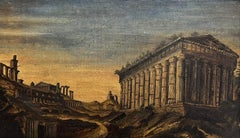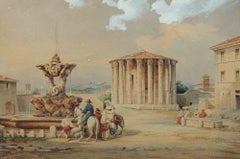Items Similar to 'The Greek Temples of Paestrum' by Paul Albert Girard, Paris 1839 – 1920, French
Want more images or videos?
Request additional images or videos from the seller
1 of 8
Girard Paul Albert'The Greek Temples of Paestrum' by Paul Albert Girard, Paris 1839 – 1920, French1839 – 1920
1839 – 1920
$3,583.96
£2,613.59
€3,000
CA$4,902.79
A$5,486.36
CHF 2,864.72
MX$67,449.11
NOK 36,141.75
SEK 34,009.21
DKK 22,829.95
Shipping
Retrieving quote...The 1stDibs Promise:
Authenticity Guarantee,
Money-Back Guarantee,
24-Hour Cancellation
About the Item
Paul Albert Girard
Paris 1839 – 1920
French Painter
'The Greek Temples of Paestrum'
Signature: Signed lower left
Medium: Aquarelle
Dimensions: Image size 29 x 49 cm, frame size 41 x 61cm
Provenance: Paestum, designated as a UNESCO World Heritage Site, stands as the best-preserved Greek archaeological site in Italy. Situated just south of Salerno, near the picturesque Amalfi Coast, and in proximity to Pompeii, Paestum remains somewhat undiscovered by many travelers.
In its prime, Poseidonia thrived, evident in the remnants of city walls, colossal temples, and the overall urban layout. As Magna Grecia expanded and established trade routes, conflicts arose between the Greek colonists and the indigenous Samnite and Lucani tribes. Archaeological findings, however, suggest a period of peaceful coexistence between the Greeks and the Lucanians.
This harmony was disrupted in 273 BC with the arrival of the Romans. The Romans, while altering the city's name to Paestum, did not obliterate it. Remarkably, their admiration for the splendidly constructed temples played a role in shaping classical architecture on the Italian peninsula, influencing subsequent Roman development and style. The Romans made additions to Paestum, including a forum, an amphitheater, a temple of their own, and residential structures, some of which still stand today.
In 79 BC, the eruption of Vesuvius dealt a partial blow to Paestum, altering its landscape. Despite this setback, the city's survival attests to its resilience and enduring cultural significance. Today, visitors can explore the fascinating remnants of Paestum, a testament to the confluence of Greek and Roman influences, and the architectural prowess that has withstood the test of time.
Born on December 13, 1839, in the artistic heart of Paris, Paul-Albert Girard emerged as a luminary in the world of 19th-century French painting. The son of the esteemed painter Pierre Girard, he inherited not just a name but also a passion for the arts that would define his illustrious career.
Biography: Born on December 13, 1839, in the artistic heart of Paris, Paul-Albert Girard emerged as a luminary in the world of 19th-century French painting. The son of the esteemed painter Pierre Girard, he inherited not just a name but also a passion for the arts that would define his illustrious career.
Paul Albert was a versatile artist, displaying his mastery across various genres – from capturing the essence of everyday life in genre scenes to breathing life into captivating portraits and landscapes. His prowess extended to watercolors, mural compositions, and the rich tapestry of Orientalist paintings depicting scenes from North Africa.
In 1857, Paul-Albert embarked on his formal artistic education at the prestigious École des Beaux-Arts in Paris. Under the guidance of eminent mentors such as Jean Joseph Bellel, François Edouard Picot, and Hippolyte Flandrin, he honed his craft and laid the foundation for a career that would leave an indelible mark on the art world.
From 1859 to 1913, his works found a home at the Salon Paris, a testament to his enduring presence and influence. Additionally, he exhibited at the Salon Dijon from 1887 to 1910 and at the Salon des Peintres Orientalistes, showcasing the breadth of his artistic vision.
In 1861, Paul-Albert Girard received the prestigious Prix de Rome in the category of 'paysage historique' (Historic landscapes), a recognition of his exceptional talent. One of his notable winning works was the compelling "The Procession of Silenus."
The year 1895 marked another pinnacle in his career when Girard was bestowed with the honor of becoming a Chevalier de la Légion d'Honneur, a fitting tribute to a lifetime dedicated to artistic excellence.
Girard's oeuvre extends beyond the borders of France, with his captivating oil painting, "Ritual Slaying of Cockerels," finding a home in the esteemed collection of the Birmingham Museum and Art Gallery.
For two decades, he turned his artistic gaze to portraiture and landscapes, capturing the beauty of Normandy, the banks of the Loire, and the picturesque Italian countryside. However, it was his large-scale Orientalist paintings that truly distinguished him, offering glimpses into the daily life of Kabylia and various regions of Algeria.
On February 24, 1920, France bid farewell to a creative genius, leaving behind a legacy that continues to captivate and inspire. Paul-Albert Girard's name resonates not only for his technical brilliance but for his ability to transport audiences to the vibrant landscapes and cultural tapestries he so masterfully depicted.
- Creator:Girard Paul Albert (1838 - 1920, French)
- Creation Year:1839 – 1920
- Dimensions:Height: 16.15 in (41 cm)Width: 24.02 in (61 cm)Depth: 2.76 in (7 cm)
- Medium:
- Movement & Style:
- Period:
- Condition:The painting is offered in ready-to-hang gallery condition, having undergone professional revision. It is presented in a high-quality fitted wooden frame, which is in excellent condition.
- Gallery Location:Knokke, BE
- Reference Number:1stDibs: LU2006210362202
About the Seller
5.0
Vetted Professional Seller
Every seller passes strict standards for authenticity and reliability
Established in 1998
1stDibs seller since 2022
26 sales on 1stDibs
Typical response time: 23 hours
- ShippingRetrieving quote...Shipping from: Knokke, Belgium
- Return Policy
Authenticity Guarantee
In the unlikely event there’s an issue with an item’s authenticity, contact us within 1 year for a full refund. DetailsMoney-Back Guarantee
If your item is not as described, is damaged in transit, or does not arrive, contact us within 7 days for a full refund. Details24-Hour Cancellation
You have a 24-hour grace period in which to reconsider your purchase, with no questions asked.Vetted Professional Sellers
Our world-class sellers must adhere to strict standards for service and quality, maintaining the integrity of our listings.Price-Match Guarantee
If you find that a seller listed the same item for a lower price elsewhere, we’ll match it.Trusted Global Delivery
Our best-in-class carrier network provides specialized shipping options worldwide, including custom delivery.More From This Seller
View AllView of Villa Discopoli, Capri, Artist 19th - 20th Century, Signed by Monogram
Located in Knokke, BE
View of Villa Discopoli, Capri
Artist 19th - 20th century
Signature: Signed by monogram bottom left
Medium: Oil on canvas
Dimensions: Image size 67 x 99 cm, frame size 87,50 x 118 cm
Provenance: Villa Discopoli is one of the most exquisite examples of twentieth century architecture on the island in Italy.
The first owner of the Villa was a close friend of Axel Munthe, Swedish-born medical doctor and psychiatrist. She sold the property in 1970 and the main part of the Villa into several self contained apartments, Gardenia, Hydrangea, Agapanthu, Oleander of exquisite charm and beauty: .
During Capri’s Romantic period it was host to several intellectuals:
Rainer Maria Rilke ( Prague, Czechia 1875 – Montreux, Switzerland 1926) , a Bohemian-Austrian German-language poet and novelist, was one of its prestigious inhabitants.
Karl Wilhelm Diefenbach...
Category
19th Century Post-Impressionist Landscape Paintings
Materials
Canvas, Oil
Terrace View dei Cappuccini, Convento di Amalfi, Charles Verbrugghe, 1877 – 1974
Located in Knokke, BE
Charles Verbrugghe
Bruges 1877 – 1974 Paris
Belgian Painter
'Terrace View dei Cappuccini, Convento di Amalfi'
Signature: signed middle right
Medium: oil on board
Dimensions: image ...
Category
Early 20th Century Impressionist Landscape Paintings
Materials
Oil, Board
View of Capri, Artist 20th century, European School
Located in Knokke, BE
Artist 20th century
European School
20th century
View of Capri
Signature: Signed bottom left, illegible signature
Medium: Oil on canvas
Dimensions: Image size 30 x 40 cm, frame size...
Category
20th Century Impressionist Landscape Paintings
Materials
Canvas, Oil
Romantic Portraits, Herman Richir, Brussels 1866 – 1942, Belgian Painter
Located in Knokke, BE
Romantic Portraits
Richir Herman
Brussels 1866 – 1942
Belgian Painter
Signature: Attributed to Richir Herman
Medium: Oil on canvas
Dimensions: Image size 67,50 x 62,50 cm, frame size 69,50 x 64,50 cm
Biography: Richir Herman Jean Joseph was born in Ixelles (Brussels), on November 4, 1866. He was a Belgian painter of portraits, still lifes, genre paintings, nudes and landscapes. He made decorative paintings to fit into private homes.
Richir mainly painted portraits. His clients usually belonged to the higher circles. He portrayed amongst others King Albert and Queen Elisabeth, Cardinal Mercier and Countess d’Oultremont. Less known are the landscape paintings he made Limburg and Kempen, where he regularly stayed with befriended artist Emile Van Doren (1865 – 1949).
Herman Richir first studied at the Sint-Joost-ten-Node Academy with Gustave Biot and Charles Hermans, continued his education at the Royal Academy of Fine Arts in Brussels (1884-1889) with the master teacher and artist Jean-Francois Portaels (1818 – 1895). In 1886, during his studies, he won second Prize of Rome for Painting.
Richir lived in Schaarbeek. In 1900 he became a teacher of drawing and in 1905 first teacher of painting after nature at the Brussels Academy. He was director there several times 1906-1907, 1910, 1911, 1915-1919, 1925-1927. He was retired in 1927.
His pupils included Albert Alleman (1892 – 1933), Éliane de Meuse (1899 – 1993), Paul Hagemans (1884 – 1959), Maurice Mareels (1893 – 1976), Guy Onkelinx (1879 – 1935), Georges Rogy (1897 – 1981), José Storie (1899 – 1961), Charles Swyncop (1895 – 1970), Maurice Schelck...
Category
20th Century Romantic Portrait Paintings
Materials
Canvas, Oil
Attributed to Pierre-Jean Hellemans, Brussels 1787 – 1845, Oil on oak panel
Located in Knokke, BE
Hellemans Pierre-Jean
Brussels 1787 – 1845
Belgian Painter
A Summer Landscape
Signature: Attributed to Hellemans Pierre-Jean
Medium: Oil on oak panel
Dimensions: Image size 62 x 78 cm, frame size 72,50 x 92,50 cm
Biography: Hellemans Pierre-Jean was born on November 21, 1787, in Brussels.
He was a Belgian pre-romantic painter of landscapes.
He was married with his niece, Jeanne Marie-Joséphine Hellemans (1796-1837). She was a painter of still lifes with flowers and fruits.
Hellemans studied at the Acade...
Category
19th Century Romantic Landscape Paintings
Materials
Oil, Wood Panel
A View of Venice, Henri Duvieux, Paris 1855 – 1902, French Painter, Signed
By Henri Duvieux
Located in Knokke, BE
"A View of Venice"
Duvieux Henri
Paris 1855 – 1902
French Painter
Signature: Signed bottom right
Medium: Oil on canvas
Dimensions: Image size 24,5 x 32,...
Category
Late 19th Century Impressionist Landscape Paintings
Materials
Canvas, Oil
You May Also Like
Temple of Paestum, Max Usadel (ca. 1880-1950), 1912, Oil Paint on Canvas
Located in Greding, DE
Max Usadel (ca.1880-1950), Temple of Paestum, dat. 1912
View of the temple of Paestum with two ox carts in the foreground. The setting sun creates a dramati...
Category
1910s Impressionist Landscape Paintings
Materials
Canvas, Oil
1800's Italian Grand Tour Oil Painting Theseus Temple Athens in Landscape
Located in Cirencester, Gloucestershire
Theseus Temple, Athens
early 1800's Italian artist
oil on canvas laid over board, framed
framed: 9 x 12.75 inches
board: 6.75 x 10.75 inches
provenance: private collection, UK
condit...
Category
Early 19th Century Old Masters Landscape Paintings
Materials
Oil
$1,566 Sale Price
30% Off
Temple of Vesta - Drawing by Roberto Gigli - 1880s
Located in Roma, IT
View of the Temple of Vesta is an orginal modern artwork realized by Roberto Gigli (1846-1922).
Mixed colored ink and watercolor on paper.
The artwor...
Category
1880s Modern Figurative Drawings and Watercolors
Materials
Ink, Watercolor
$985 Sale Price
25% Off
The Temple of Concordia, Agrigento - English School drawing, 19th Century
Located in Middletown, NY
A lovely grand tour image of the Doric architectural masterpiece dedicated to Castor and Pollux.
Dated 1863.
Watercolor and graphite on lightweight card stock, 10 x 13 3/4 inches (2...
Category
Mid-19th Century English School Landscape Drawings and Watercolors
Materials
Watercolor, Cardboard, Graphite
Ruins of the Ancient Aqueducts by Carl Friedrich Heinrich Werner - 1872
By Carl Friedrich Heinrich Werner
Located in Roma, IT
Ruins of the Ancient Aqueducts is an original artwork realized by Carl Friedrich Heinrich Werner (Weimar, 4 October 1808 – Leipzig, 10 January 1894) in 1872.
Watercolour and pencil on paper.
Hand-signed and dated on the lower left corner: C. Werner 1872.
Good conditions. Prov. Collection Dr. Peter Nicolaus (1940-2020).
Carl Friedrich Heinrich Werner (4 October 1808 – 10 January 1894) was a German...
Category
1870s Modern Figurative Drawings and Watercolors
Materials
Watercolor, Pencil
Rome 1878 Classical Roman Architecture Figures at Fountain Signed Watercolor
Located in Cirencester, Gloucestershire
Rome
by Arthur A. Wilkinson (British, c.1860-1930)
signed and dated 1878
watercolor on artist paper , unframed
artist paper : 11 x 17 inches
Provenance: private collection, the Cotsw...
Category
19th Century English School Landscape Paintings
Materials
Watercolor
More Ways To Browse
Greek Temple
19th Century Greece Painting
Temple Rome Antique
Pompeii Painting
Antique Forum
Tapestry French Romantic
19th Century Portrait African
Indigenous Tapestry
Roman Forum
Antique Art Forum
Romantic Scenes Tapestry
Artist Girard
Amalfi Painting
Vesuvius Painting
Amalfi Coast Painting
Pompeii Wall Painting
Oil Painting Amalfi
Amalfi Coast Oil Painting
